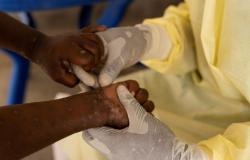The Marburg virus has just killed eleven people in Rwanda, a country in eastern Africa where an epidemic has been raging since September 27.
The worry persists. The total number of victims of the Marburg virus in Rwanda now stands at eleven after the death of five additional people from this hemorrhagic fever similar to Ebola, the Ministry of Health announced late Tuesday, October 1. Here is what we know about this disease.
What is Marburg virus disease?
Marburg virus disease is a very virulent hemorrhagic fever that is dangerous for humans. Additionally, case fatality rates are very high, having varied from 24% to 88% in previous outbreaks, depending on the virus strain and case management, according to the WHO.
This disease was first discovered in Marburg (Germany) in the 1960s.
Researchers suddenly fell ill while working on a vaccine based on monkey cells. They are considered the first cases of Marburg virus disease.
What are the symptoms?
Marburg virus disease is rather difficult to identify, because the symptoms are similar to those of other tropical diseases, such as Ebola or malaria.
The first symptom experienced most of the time remains fever, arriving suddenly and at high intensity. The patient may also have intense headaches, sometimes causing discomfort.
In 2023, the WHO reported nine deaths, and 16 suspected cases with symptoms such as fever, fatigue, vomiting and bloody diarrhea.
How is the disease transmitted?
The Marburg virus is transmitted to humans by fruit bats and spreads in humans through direct contact with the bodily fluids of infected people, such as blood, urine or semen for example. People can also be affected by direct contact with infected surfaces or materials.
For the moment, this disease is mainly present on the African continent. Epidemic outbreaks have been declared in the past in South Africa, Angola, Uganda, Ghana, and more recently in Rwanda.
Is there a treatment?
Currently, no vaccine against Marburg virus disease exists, despite the disease being first observed more than sixty years ago. In order to limit the disease as much as possible, patients undergo oral or intravenous rehydration treatments, but also the treatment of certain specific symptoms helps increase the chances of survival.
According to the WHO, a range of potential treatments, including blood products, immune therapies and drugs, as well as vaccine candidates with phase 1 data are being evaluated.







